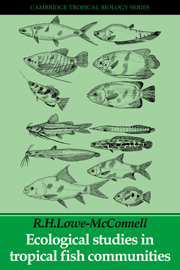Book contents
- Frontmatter
- Contents
- Preface
- Acknowledgements
- PART I INTRODUCTION
- PART II FRESHWATER STUDIES
- PART III MARINE FISH STUDIES
- PART IV SYNTHESES
- 11 Responses of fishes to conditions in tropical waters
- 12 Trophic interrelationships
- 13 Diversity: its maintenance and evolution
- 14 The exploitation and conservation of tropical fish stocks
- Appendix: Fish families in tropical waters
- References
- Index
13 - Diversity: its maintenance and evolution
Published online by Cambridge University Press: 07 May 2010
- Frontmatter
- Contents
- Preface
- Acknowledgements
- PART I INTRODUCTION
- PART II FRESHWATER STUDIES
- PART III MARINE FISH STUDIES
- PART IV SYNTHESES
- 11 Responses of fishes to conditions in tropical waters
- 12 Trophic interrelationships
- 13 Diversity: its maintenance and evolution
- 14 The exploitation and conservation of tropical fish stocks
- Appendix: Fish families in tropical waters
- References
- Index
Summary
High diversity at low latitudes is a characteristic of both plant and animal communities, and fishes are no exception to this generalization, for among both freshwater and marine tropical fishes greater diversity is shown both within taxa and within communities than at high latitudes. This chapter examines first how species are packed into communities and coexist, and then how these very diverse communities have evolved.
Diversity maintenance
Previous chapters have indicated that diversity is greatest in relatively aseasonal communities, both in freshwaters and in the sea (Table 11.1). Coral reefs carry the most diverse of any fish communities; upwelling areas in the sea have far less diverse faunas than those on reefs. Diversity in rivers becomes less: (1) as the latitude increases and seasonal fluctuations in water level become more marked; (2) with increases in altitude, for example in Andean and Kenyan streams, where this is probably a temperature effect; and (3) towards the headwaters of streams where physicochemical factors, obstructions causing water falls, high speeds of flow, and the size and conditions of dry–season refuges, may be more limiting than food resources.
Fauna lists are very large for many tropical water bodies, but how many species actually share biotopes? The long species lists for a river system could result from each section and the innumerable tributary streams each having its own fauna.
- Type
- Chapter
- Information
- Ecological Studies in Tropical Fish Communities , pp. 287 - 304Publisher: Cambridge University PressPrint publication year: 1987

